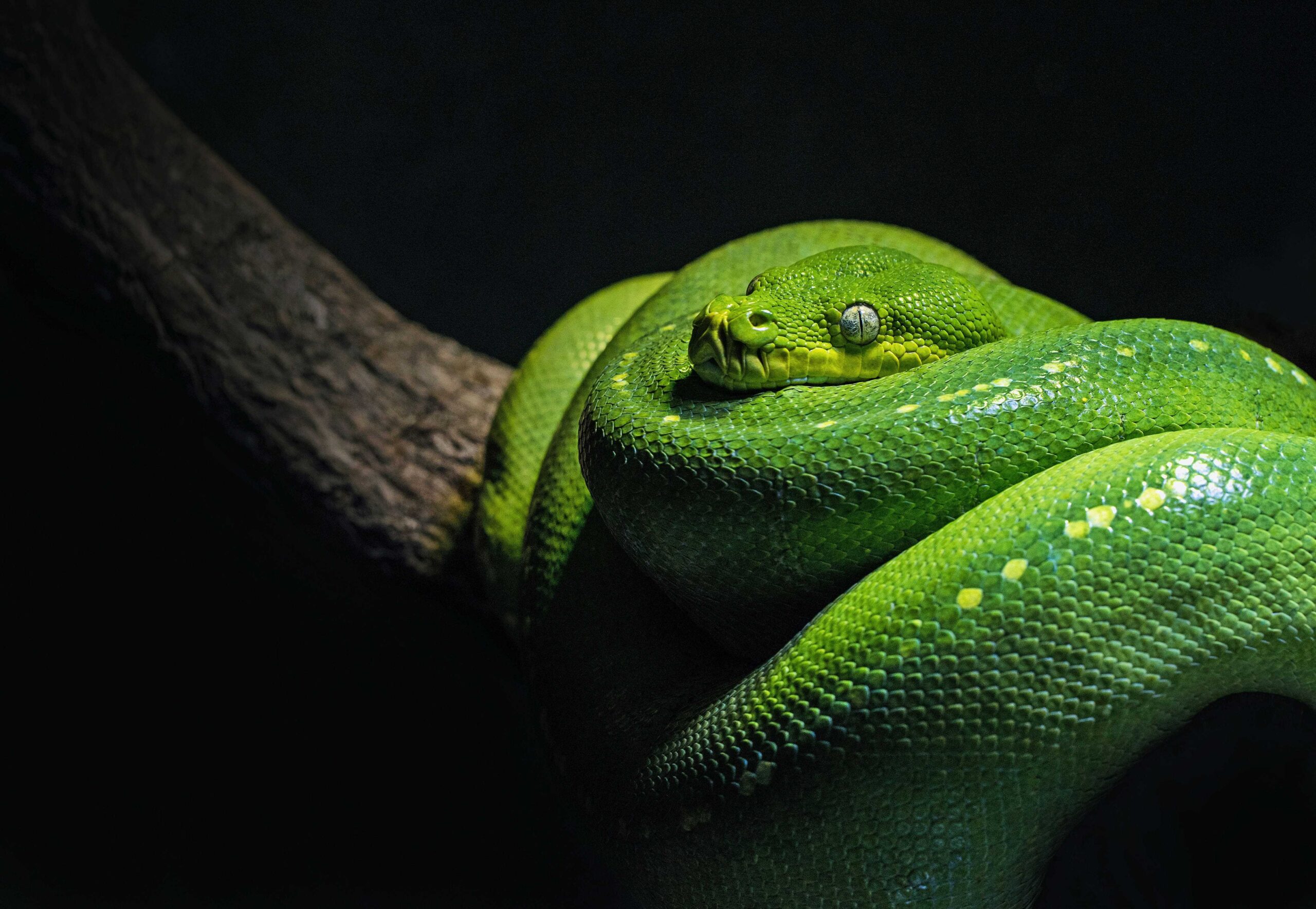Bali is an island covered in tropical rainforest. If there were no snakes in Bali it would be a very strange place, indeed.
In fact, there may be as many as 70 different species of snakes in Bali (50 on the land, 20 more in the sea).
They can be found all over the island (though there are fewer snakes at altitudes above 1,000 meters) and in the water too.
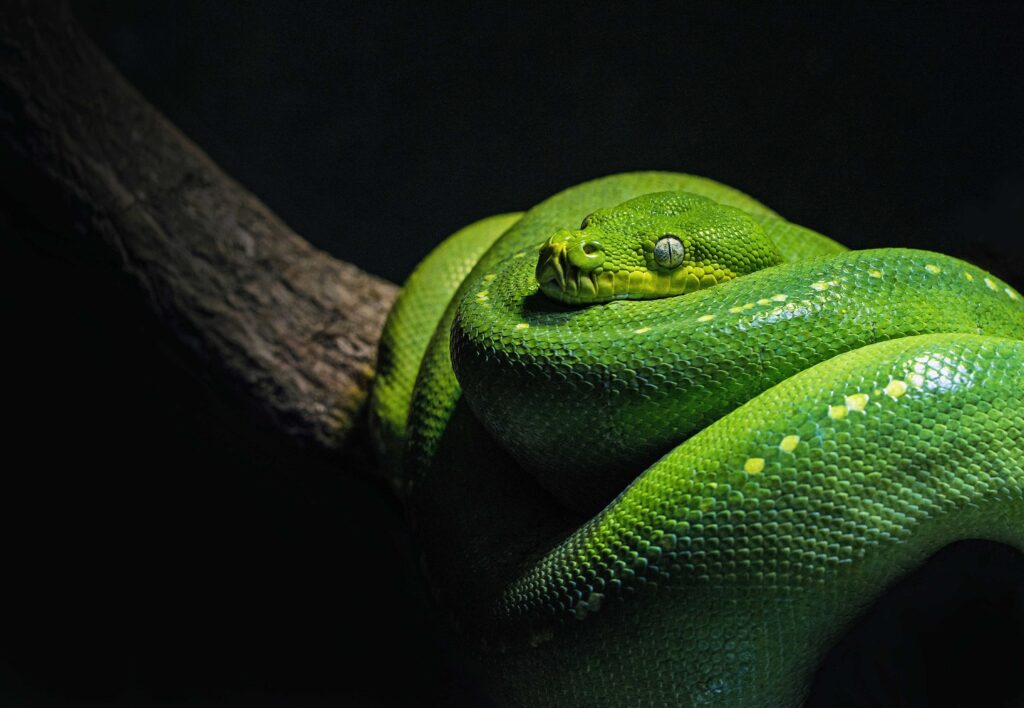
It’s fair to say that the snakes in Bali were the original inhabitants of the island and were here long before humans arrived.
Mostly, they prefer to live in places far away from people but development on the island has seen people encroaching on traditional snake territory.
Our guide to snakes in Bali, will explain how snakes feel about you, what to do if you’re bitten, introduce you to the 31 most common species of snakes here and more.
Most of all, we hope that you will understand that though the idea of snakes in Bali may be distressing most people’s holidays involve no snake encounters whatsoever, so don’t let them put you off booking your trip.
About Snakes In Bali & People
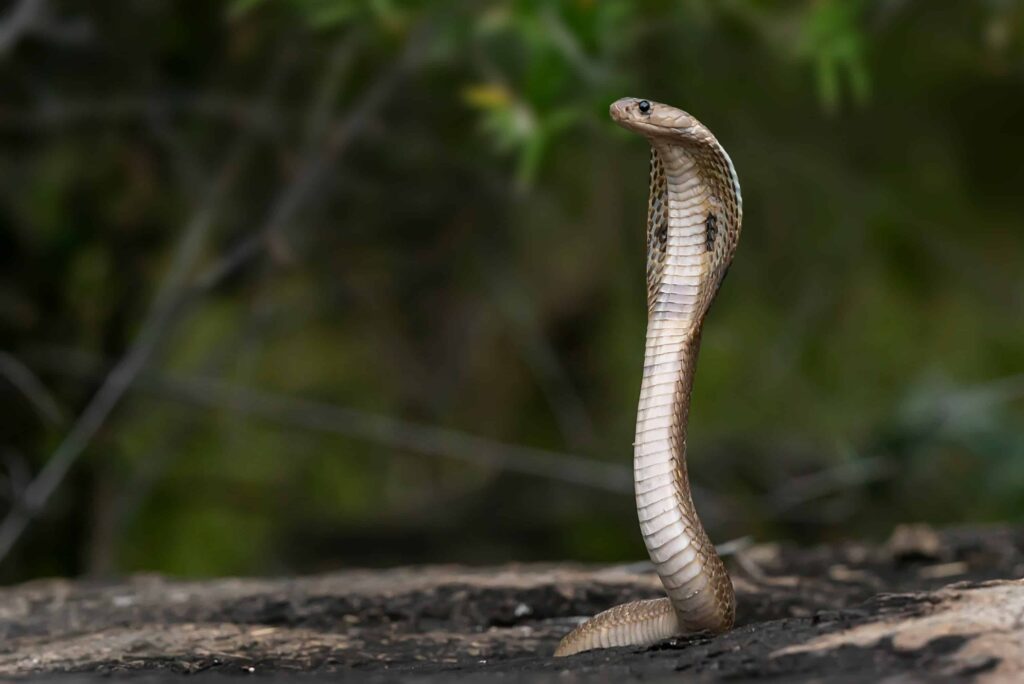
We need to stress before we take a look at any snakes in Bali that snakes do not live to bite people.
In fact, snakes would much prefer never to bite anyone at all. A snake can’t eat a person. Thus, any venom spent on biting a person is, from a biological perspective, wasted.
The snake has to spend energy and calories making venom. If it wastes it, it will eventually starve to death.
That means that as a general rule of thumb if you don’t mess with a snake, it won’t mess with you.
If you see a snake, don’t set out to kill or harm it (this is technically illegal anyway – even if the law is not enforced) and you are concerned about it – call a snake catcher.
They will be happy to find the snake, capture it and move it somewhere that it can do no harm and go about its snake business in peace.
You should be aware that you are really only at risk of snake bites when walking through very thick vegetation or at night with poor lighting, this dramatically increases your chances of accidentally stepping on a snake and as you can imagine, that’s not very nice for the snake.
The 7 Most Venomous Snakes In Bali

There are 7 snakes in Bali which are the most venomous snakes and generally speaking, it’s a bad idea to get bitten by these fellows.
We’ve included, where possible, common names, local names and scientific names of each snake to allow you to better communicate with medical professionals if you are bitten.
If you encounter snakes of these kinds, you should call a professional snake catcher and let them handle them. Never try to capture these snakes yourself, the risks are far too great.
Island Pit Viper/Ular Hijau/Lipi Gadang (Tremeresurus Insularis)
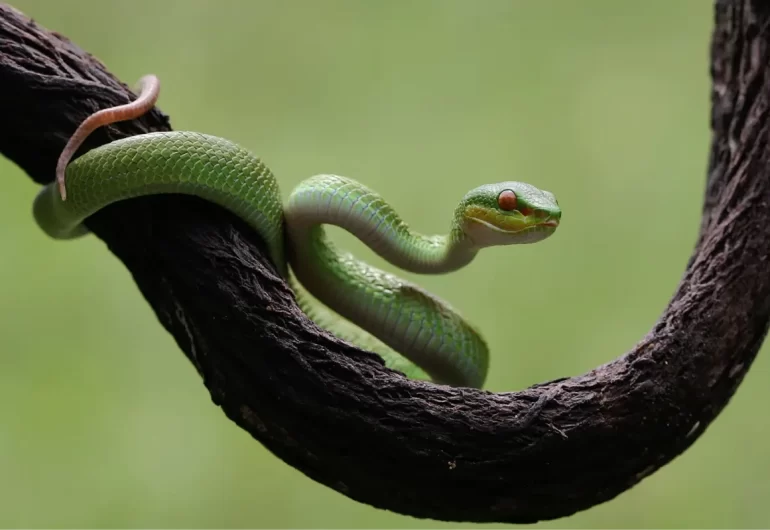
Pit vipers are very common in Bali and they tend to live in the kilometre between the coast and the interior of the island.
The island pit viper can be either light or dark green in colour. The head is shaped like an arrow, they have red eyes, and the neck is slim and joins a short and rather plump body (it’s less than a meter long).
An island pit viper also has a short red tail which makes it easy to distinguish from other green snakes in Bali. This is important as most other green snakes are non-venomous snakes.
Without a doubt, the most common snake bite in Bali is the venomous bite of the island pit viper.
The snake bite victim, of an island pit viper, will feel immediate and severe pain. The venom will cause local (and sometimes body-wide) swelling.
The island pit viper venom is necrotic, which means it causes tissue death and may result in internal bleeding too.
If you don’t treat the island pit viper bite, the limb where the snake bite occurred may need to be amputated.
The bad news is that there is no anti-venom anywhere in Indonesia that can treat these bites of the island pit viper.
The good news is that most bites from the island pit viper are not venomous, but rather “dry bites” (that is they don’t inject venom) and thus, might not need treating at all.
Immediate hospitalization is essential for anyone bitten by these venomous snakes – doctors can help to reduce swelling, pain and the spread of the venom.
The earlier you get treatment, the more likely you are to survive this snake’s bite.
Javan Spitting Cobra/Ular Sendok/Lipi Uoh (Naja Sputatrix)
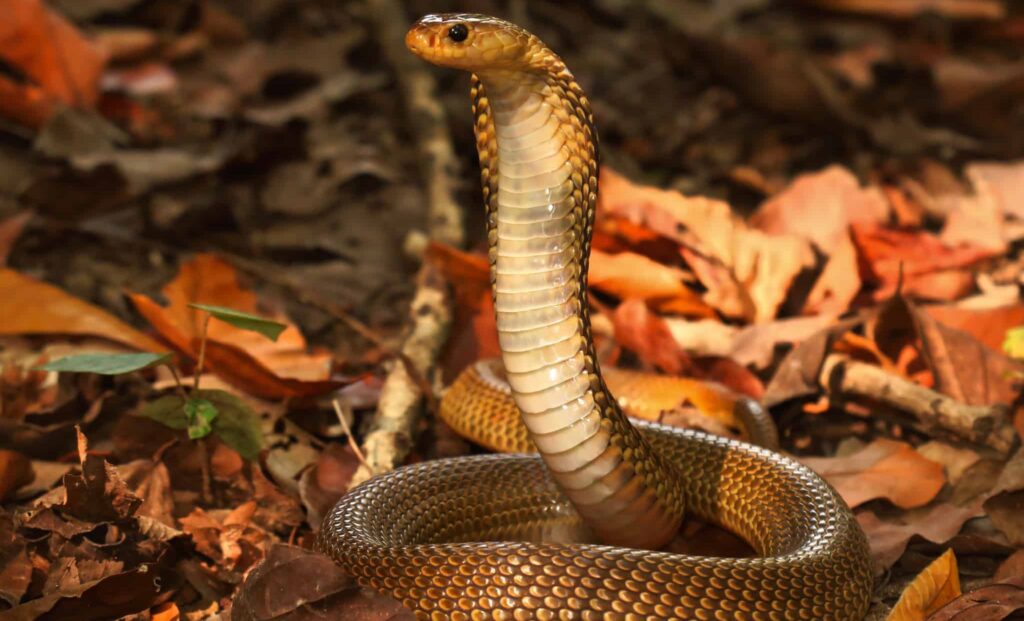
The Javan spitting cobra in Bali is a highly venomous snake. The good news is that there is anti-venom in some of the island’s hospitals to help treat the bites of spitting cobras.
However, you should be aware that they don’t call it the spitting cobra for nothing and it doesn’t just bite, a Javan spitting cobra can spray venom at a distance of up to 2 meters away!
If you find a spitting cobra in Bali, it won’t look like much, it’s a dull brown or sometimes dark olive colour and unlike spitting cobras in other countries, it does not extend its hood while it’s moving around.
The non-venomous rat snake can easily be mistaken for a Javan-spitting cobra when its hood is not extended.
It’s only when a Javan-spitting cobra is trapped or somehow under threat that the spitting cobra sits up and splays the hood out (an indication that it will soon spit and/or strike).
They can be found all over the island and normally come out between 12 noon and 3 p.m. but can stay out until after the sun goes down at times. They hunt small wildlife including birds, rodents, and even other snakes.
The most common attacks from the spitting cobra are not on people but rather spray venom attacks on cats and dogs.
If you find a cat or dog rolling around trying to get rid of the venom in their eyes, you should rinse their eyes with water for about half an hour, but do not rub them!
Blue Krait/Ular Weling/Lipi Poleng (Bungaruse Candidus)
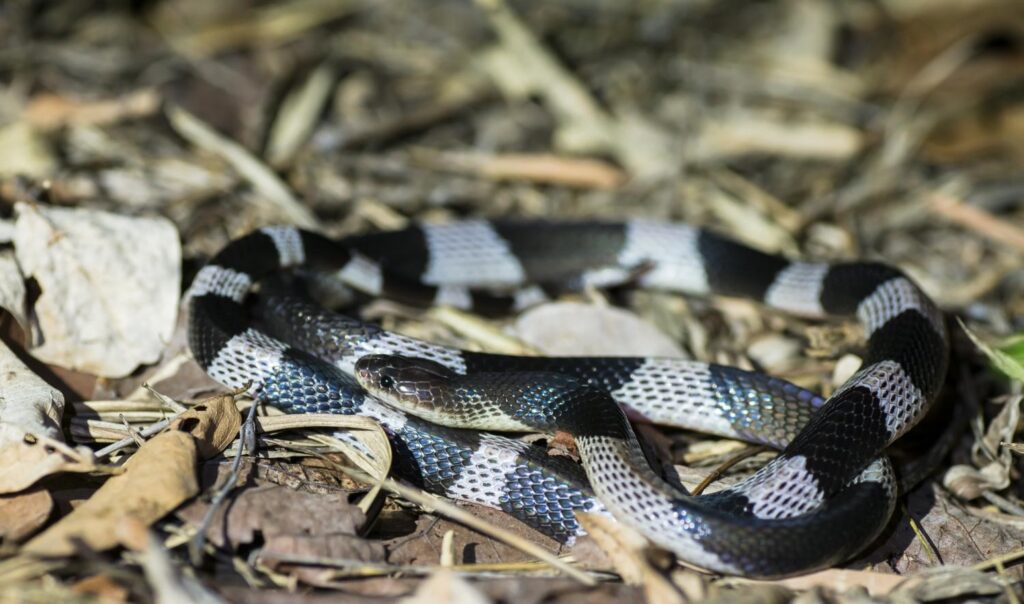
The most venomous snake in Bali is the blue krait. Well, technically, it’s the most venomous of the land snakes in Bali as with everywhere else in the world land snakes are less venomous than their aquatic cousins.
Annoyingly, the blue krait is not in the remotest bit blue and in fact, has black and white rings around the body (of roughly equal width) or it may be a single colour (dark brown, orange, a sort of blotchy black or even grey).
This makes identifying the blue krait a bit of a pain and it is often mistaken for a less dangerous snake by curious snake hunters.
The best way to tell you have a blue krait is to take a good look at the scales on the spine, these are much larger than the rest of its scales, however, if you’re that close to a blue krait, you’re way too close to it.
They are a nocturnal breed and often come out after the rains have come. They patrol the perimeter of buildings seeking prey such as lizards and rodents.
They really hate bright light and will flee from a torch beam (or bury their heads under their coils to shield their eyes).
This snake strikes quickly and efficiently and in almost any direction. The bad news is that their bite doesn’t hurt when you are bitten. The bitten limb may not register anything for a long time after the bite, in fact.
The worst news is that there is no anti-venom for this snake bite, but if you are taken to hospital, they can put you on a ventilator to help you continue to breathe until the effect of the bite wears off.
Banded Krait/Ular Welang/Lipi Poleng (Bungarus Fasciatus)
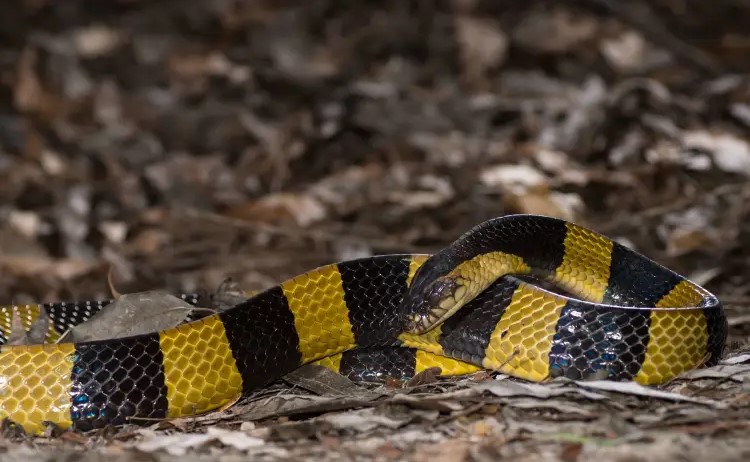
The banded krait, which is not to be mistaken for the banded sea krait, is another highly venomous creature in Bali.
It has a similar appearance to the blue krait, though the rings tend to be yellow and black and it has a blunt tail. It can grow up to 2 meters long and is not native to the island.
The banded krait probably arrived on ships from Java a century or two ago. It’s not a Malayan krait but it has a very similar appearance to the Malayan Krait. (A Malayan Krait has a blue rather than black cross band).
They tend to patrol the rice fields very late at night, which means banded krait attacks on humans are very rare. It moves along the ground in a slow fashion. It’s one of the worst snakes in Bali at climbing and can only really get over a rough wall surface or very low vegetation.
Most krait bites in this part of the world are caused by sleeping on mats on the floor and then rolling over onto the snake while the person is asleep.
If you sleep in a bed and don’t go skipping around in rice paddies after midnight, you should never get bitten.
There is an anti-venom for this snake’s bite but the challenge is to live long enough to get to the hospital to get it. You must immobilize the limb using splints and rush to a hospital if bitten by a banded krait.
Banded Sea Krait/Ular Laut (Laticauda Colubrina)
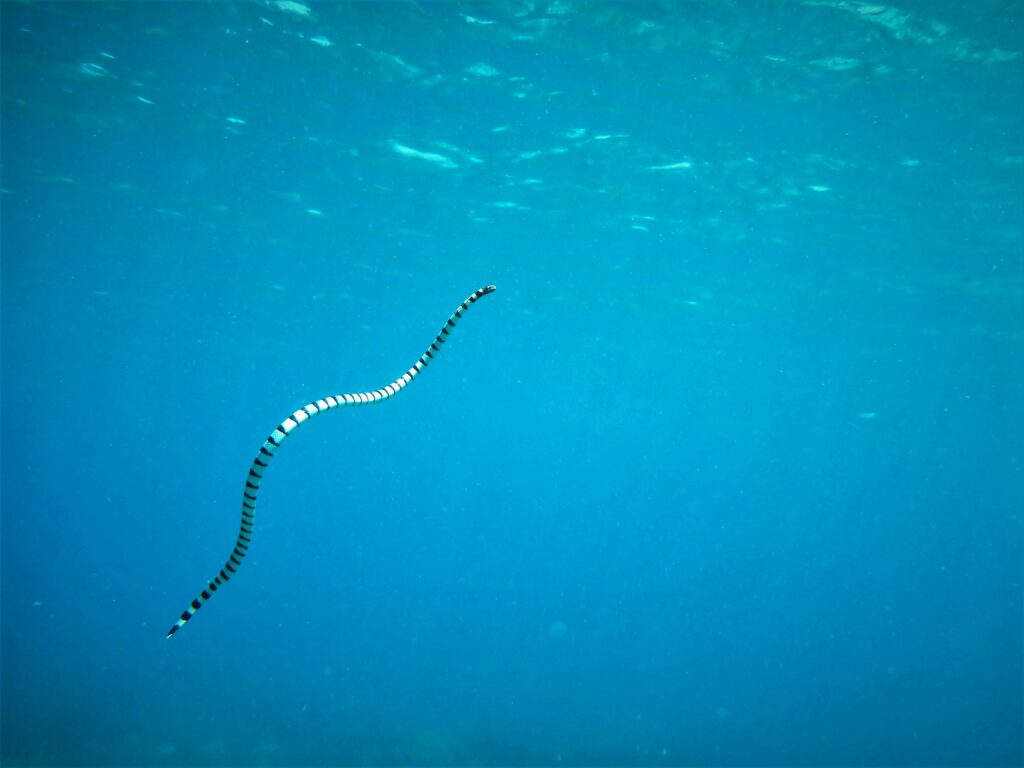
The Banded Sea Krait is one of the “sacred snakes in Bali” and you can find banded sea kraits around the Tanah Lot Temple in small caves below the surface of the waters.
Banded sea kraits are very similar in appearance to the kraits found on land but the significant difference is that a banded sea krait will have a paddle-like tail to help it move through the water.
Most sea snakes have similar adaptions to allow them to swim. It’s the easiest way to separate sea snakes from land snakes.
The banded sea krait is also a very chilled-out sea snake.
In fact, they don’t like to bite but that doesn’t mean that this sea snake won’t bite (local myths say this creature won’t bite and even if it did bite, its mouth is too small to bite, neither of these things is true).
If you do get bitten by this snake, it will not let go until forced to do so, but that might not matter much as the rumours that this snake won’t bite probably stem from the fact that you may not live long enough to get to shore to get any treatment for its highly venomous bite.
This snake may also be known as the yellow-lipped sea krait or the colubrine sea krait.
Asian Coral Snake (Calliophis intestinalis)
Asian Coral Snakes are very venomous snakes but that’s OK. To date, there has never been a confirmed Asian Coral Snake on a human being in Bali.
This is probably because the Asian Coral Snake (Calliophis intestinalis) is a very small snake. They are less than a foot long and tend to bury down into the soil or lay below a layer of leaf mulch.
You can identify them easily from the long orange stripe down the centre of the body.
This snake lives at higher elevations than most snakes in Bali and eats baby snakes and lizards.
As you might expect for a snake that’s never been known to bite anyone, there’s no anti-venom for its bite. So, don’t go out and become the first-ever victim of an Asian Coral Snake, please.
King Cobra/Ular Raja (Ophiophagus Hannah)
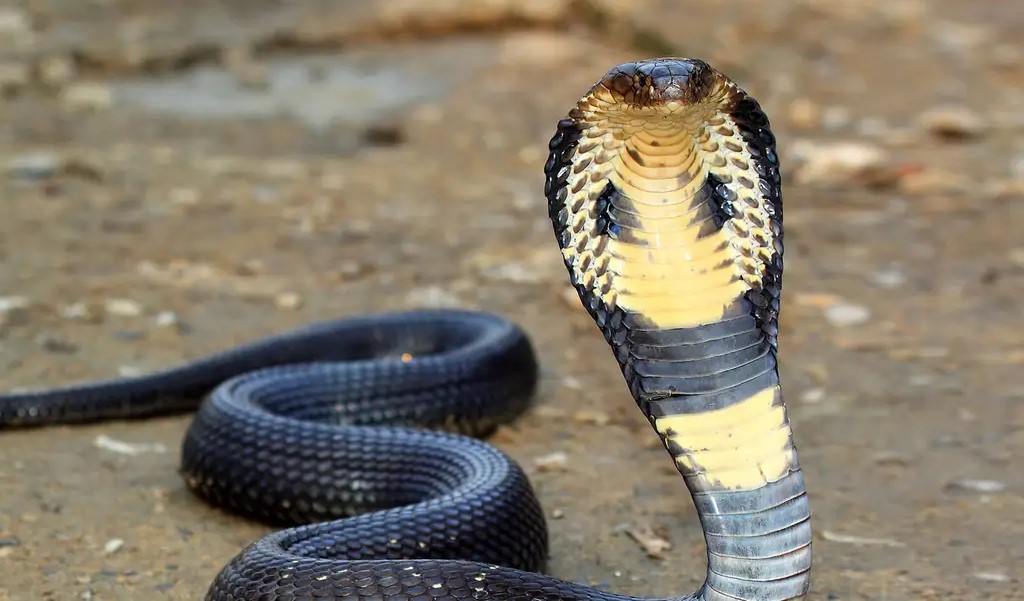
The King Cobra is the longest venomous snake in the world. It can reach lengths of over 5 meters (though specimens so far found in Bali seem to be smaller than this – averaging around 3 meters) and the King Cobra looks nothing at all like a spitting cobra.
The young King Cobra is nearly all black with just some faint white striping in a diagonal pattern down the length of the body.
The adult King Cobra has a stronger diagonal stripe marking and the body turns from black to a dark brown or olive colour.
The King Cobra lives in West Bali at the moment and tends to hunt the bamboo groves there.
However, it’s entirely possible that this snake species will eventually move into other parts of the island as it nests and breeds.
King Cobra bites are generally not a major problem. The King Cobra is an “intelligent snake” which means that it tries to conserve venom (which is a smart thing to do from a biological perspective).
It doesn’t dry bite, but it only normally releases small quantities of venom if it bites (this is why the King Cobra is popular with snake charmers).
However, we should point out that if a King Cobra gets highly stressed it ups the venom in its bites.
So, don’t go grab one and start flinging it around for an Instagram moment. (And sadly, this is the number one cause of death by the bites of King Cobras in Indonesia, today).
Treating King Cobra bites is not easy, not least because there’s no anti-venom for King Cobras in Indonesia. So, try not to get bitten.
We should note that this snake is very shy in the wild and tends to avoid people entirely. If you do encounter an angry cobra, it’s usually because you’re between it and its eggs. Move sideways rather than backwards or forwards and you should be fine.
24 Other Common Snakes In Bali

There are quite a lot of other species of snake on the island and we can’t list them all but these are the most common.
White-lipped Pit Viper
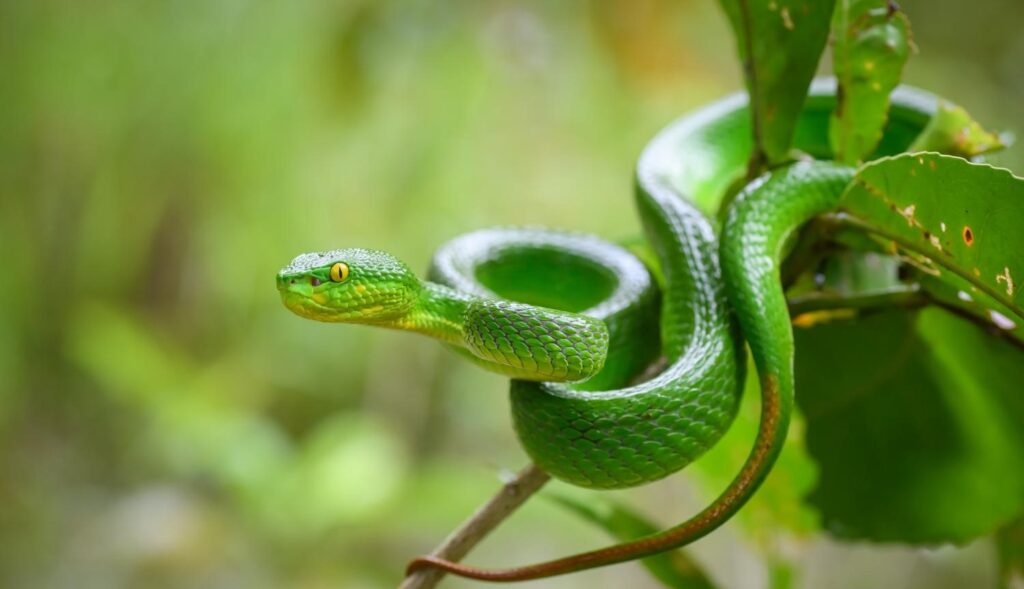
This is a close relative of the island pit viper (Trimeresurus insularis) and it lives in trees.
It tends to eat birds and mammals but bites on humans aren’t all that rare, fortunately, it’s mildly venomous and its venom promotes blood clotting which makes the wounds heal quickly.
The colouring is green with a thin white lip, hence the name.
Red-Necked Keelback Snake
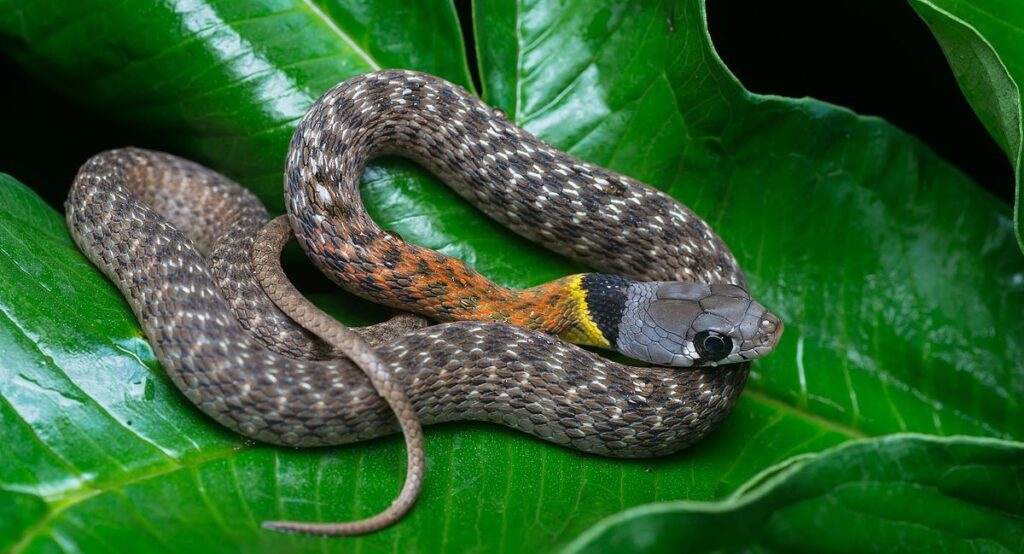
This olive-bodied snake (though sometimes nearly grey during moulting) has a white checked pattern on the body. The head has some yellow or even red colouring and it has a black coloured “necklace”.
It’s a very passive snake with rear fangs but don’t play with it. It’s still a snake with venom and bites from this snake have resulted in fatalities.
Brahminy Blind Snake

This tiny little snake is only about 2-4 inches long and it’s the smallest snake in Bali.
Oddly, it’s quite worm-like and it’s both blind and reproduces through pathogenesis (that is it can divide and make copies of itself).
It presents no threat whatsoever to human beings.
Burmese Python
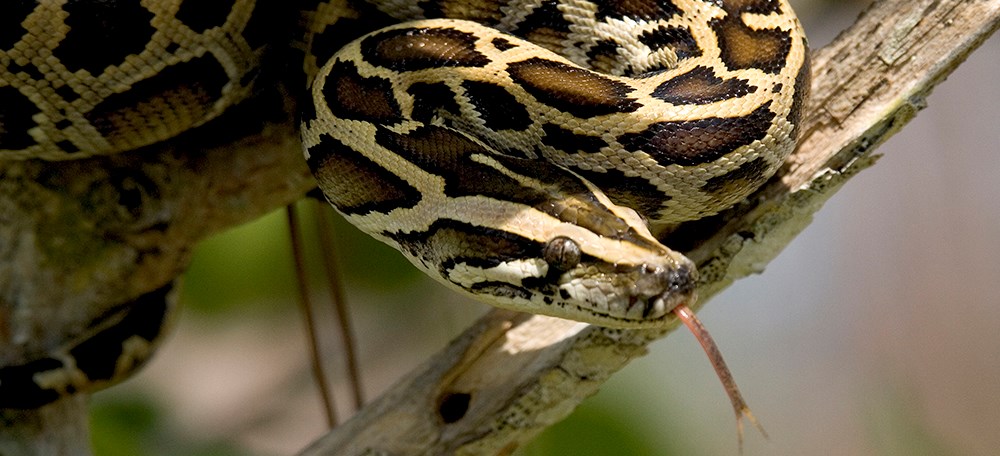
From a small snake to one of the biggest in the world, the Burmese Python can grow up to 18 feet long!
They are dangerous to people but they strangle rather than bite and oddly, they are very popular as pets.
Their skin is highly valued in the fashion industry.
Reticulated Python
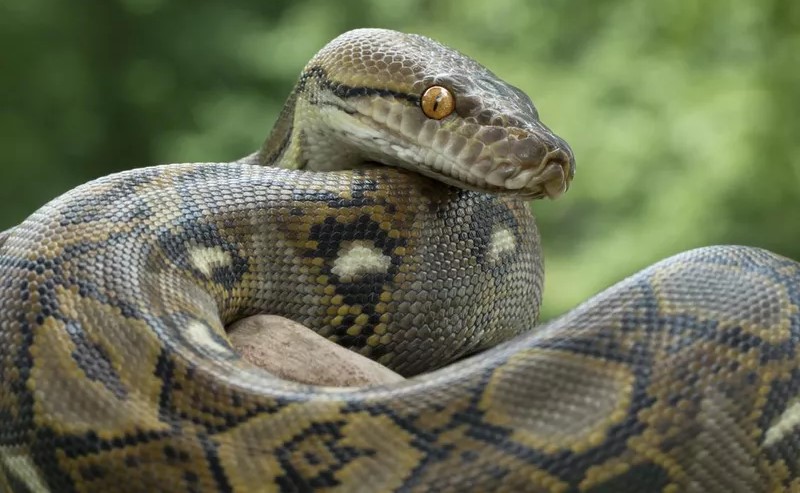
The largest snake in Asia is the reticulated python and it’s another constrictor.
Unlike nearly all other snakes, this snake will actively hunt humans if it’s hungry and should be avoided at all costs.
Chinese Rat Snake
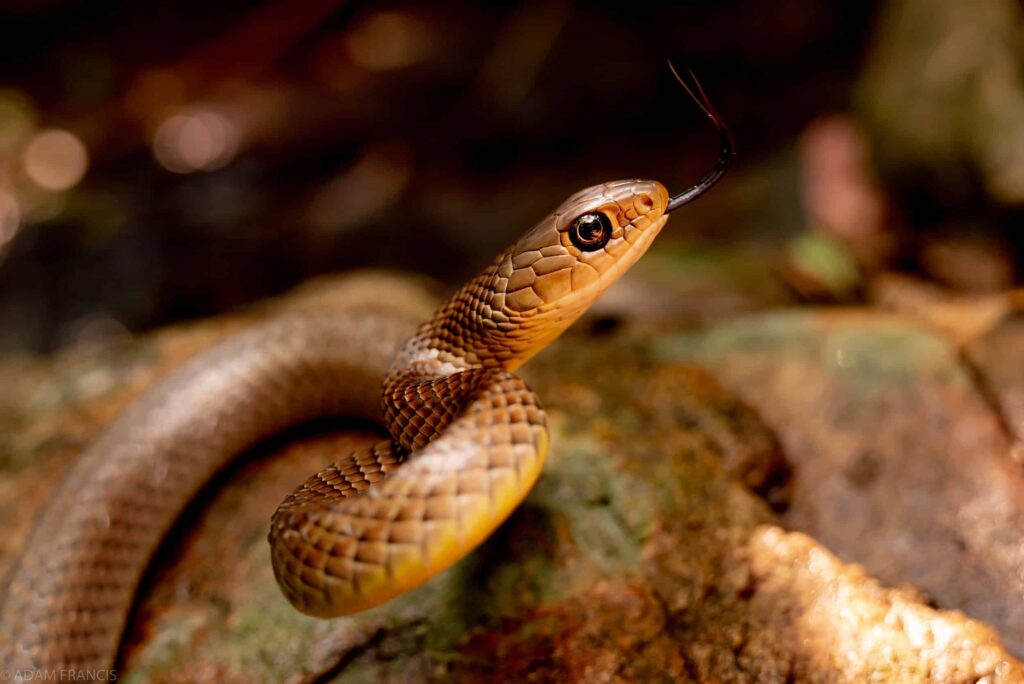
This rat snake is long and thin and has extremely round eyes. It’s a brown-coloured snake with an olive tail.
It’s very fast and hunts rats as the name suggests. It is mildly venomous but presents no threat to humans.
Oriental Rat Snake
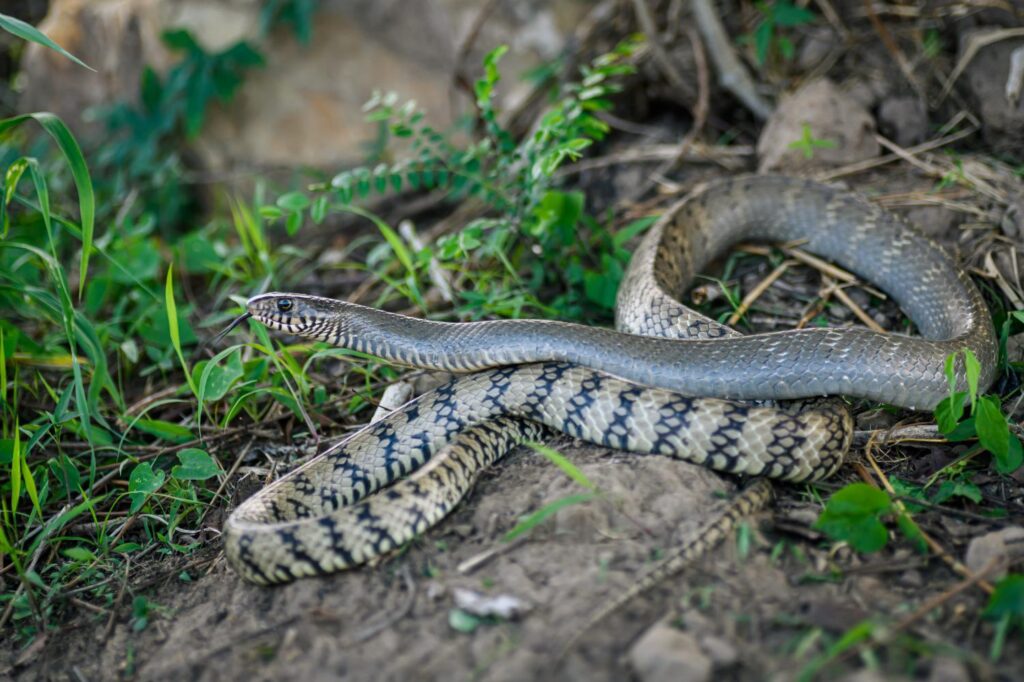
The oriental rat snake is similar in appearance to the Chinese rat snake but has more variation in colour.
It’s a very fast snake and has been known to hunt, kill and eat cobras! However, they do not attack humans and are not very venomous.
Radiated Rat Snake

This rat snake gets his name from the black marks that radiate out from his eyes.
If you surprise this snake he may try “thanatosis”, that is he may play dead, to deter you from coming close, but he may also bite – so it’s best not to surprise one.
It’s most active in the daytime and while it can climb trees, very well, it almost never does.
White-Banded Wolf Snake
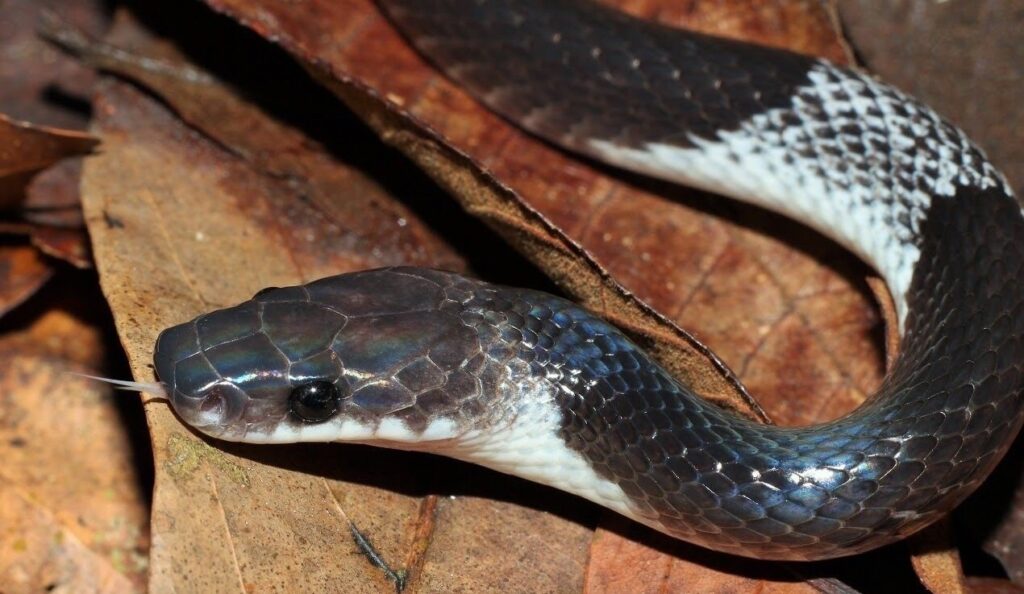
Sadly, this group of snakes don’t have any resemblance to wolves, which you have to admit would be kind of awesome.
In fact, they look a bit like kraits, which is unfortunate as they are not in the slightest bit venomous and people often kill them by mistake.
They can bite though and the bites are still painful, so don’t pick one up.
Oriental Wolf Snake
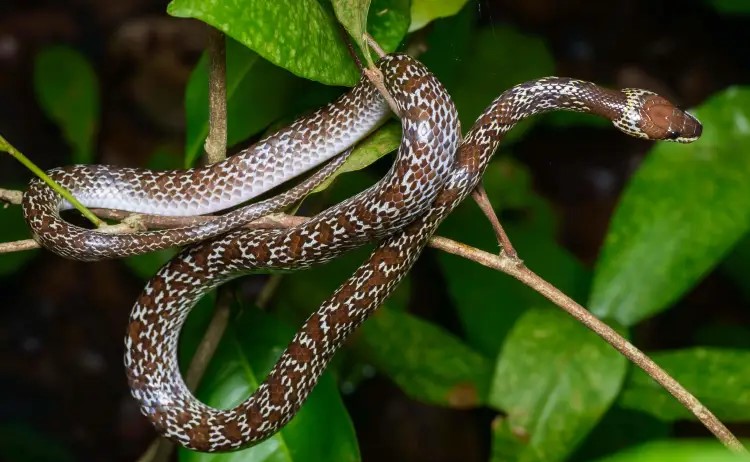
This wolf snake has very wolf-life front teeth and it’s an earthy coloured snake with a sort of white necklace near its head.
It does have venom but it’s no worse than a bee’s venom for humans, it’s deadly to the lizards that this snake eats though.
Indian Wolf Snake

This snake also looks like a common krait and that’s a form of “Batesian mimicry” which allows the snake to spend less effort defending itself from its natural foes.
Sadly, it makes people more likely to kill it in error though.
It also fakes death when surprised but will fight if there’s no other option. Biologists are not entirely sure what it eats but lizards and frogs are a good bet.
White-Bellied Blind Snake
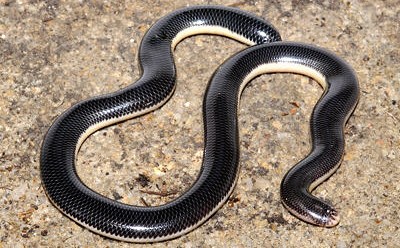
This is another worm-like snake and can grow up to 18 inches in length. It has a round head on a cylindrical body and mainly lives underground.
It eats worms, insects and larvae and is not, technically, blind as it can react to light.
Dog-Faced Water Snake
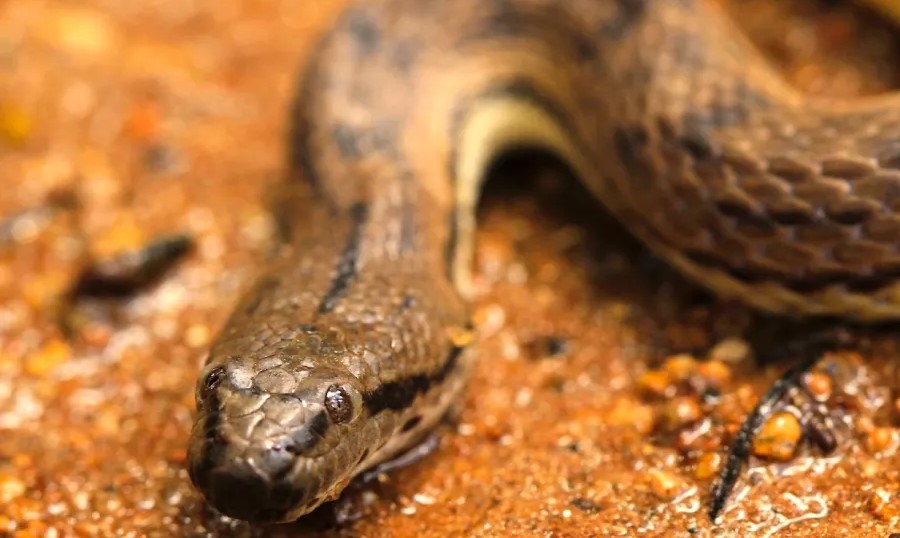
They say its name comes from the fact that its eyes are protruding from its face but frankly, it doesn’t look much like a dog to us.
It’s a saltwater reptile and its colour scheme helps it to blend in around mud and leaves.
It can bite, it is very mildly venomous and not dangerous. It also steals its dinner from other snakes by being faster than them.
Asian Vine Snake
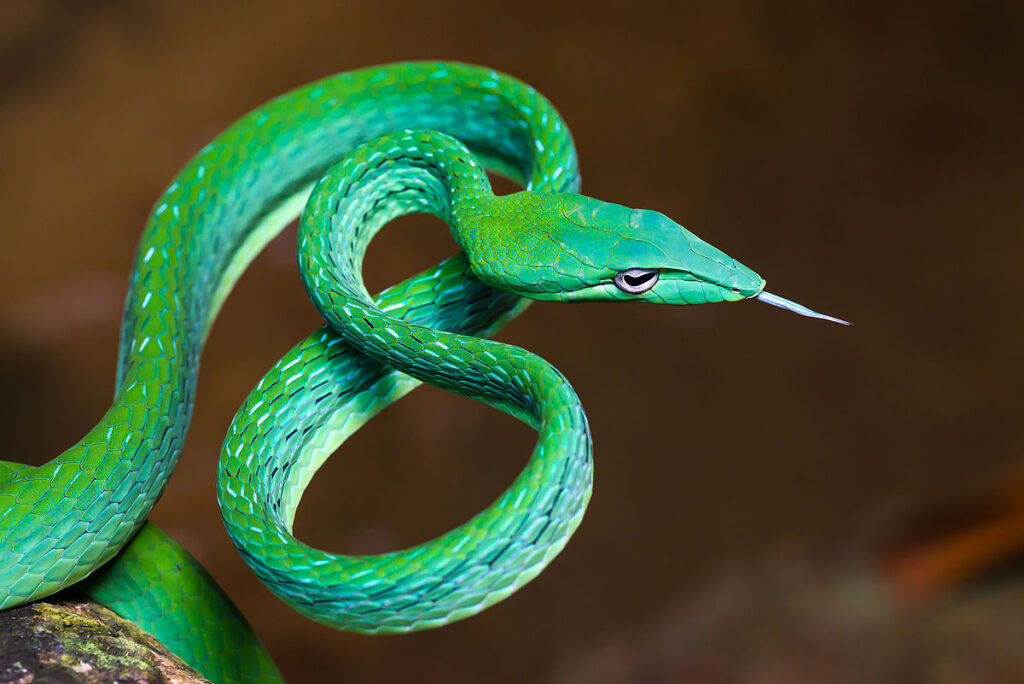
Bites from this snake are quite common as its green colouring helps it blend in rather too well with the scenery.
Fortunately, this snake isn’t very venomous and a bite is not harmful to people.
It’s one of the most popular first pets for would-be herpetologists as it will eat lizards, frogs, rodents and birds.
Painted Bronzeback
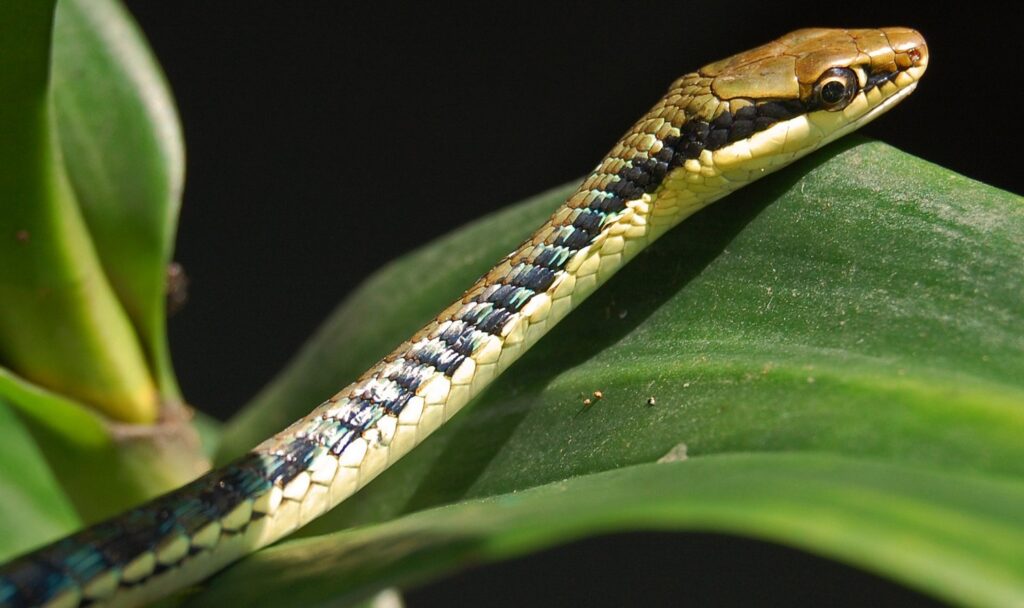
This snake really hates being around people or any other kind of possible trouble and usually runs away as soon as it thinks that it’s in danger.
Its colouring makes it very hard to spot and it’s only when it’s under threat or eating that it inflates its body to reveal its beautiful turquoise markings.
Paradise Flying Snake
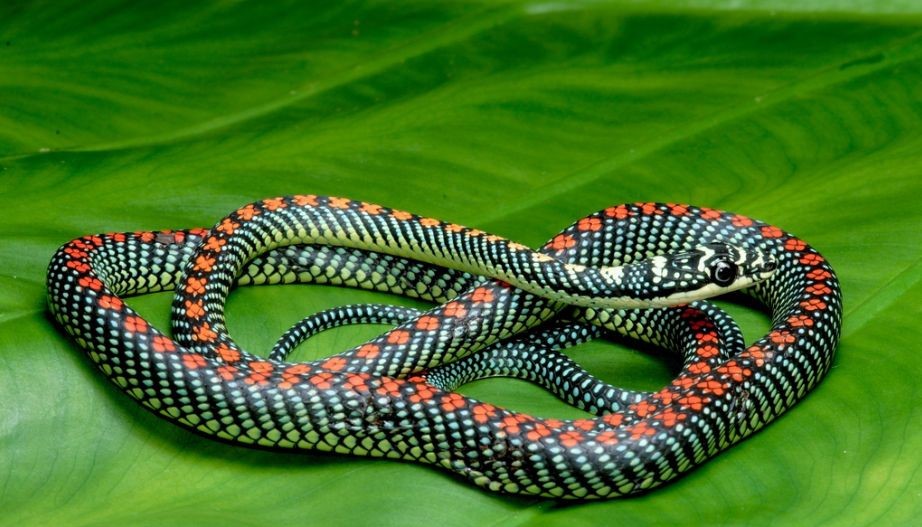
This is a rare species of snake that lives in the trees in Bali and oddly, it really can fly, well, it really can glide.
In fact, this snake can glide from one tree to another covering over 30 feet in the air. It’s a spectacular thing to see.
They eat frogs and lizards and have a mild venom which isn’t particularly dangerous to people.
Dog-Toothed Cat Snake
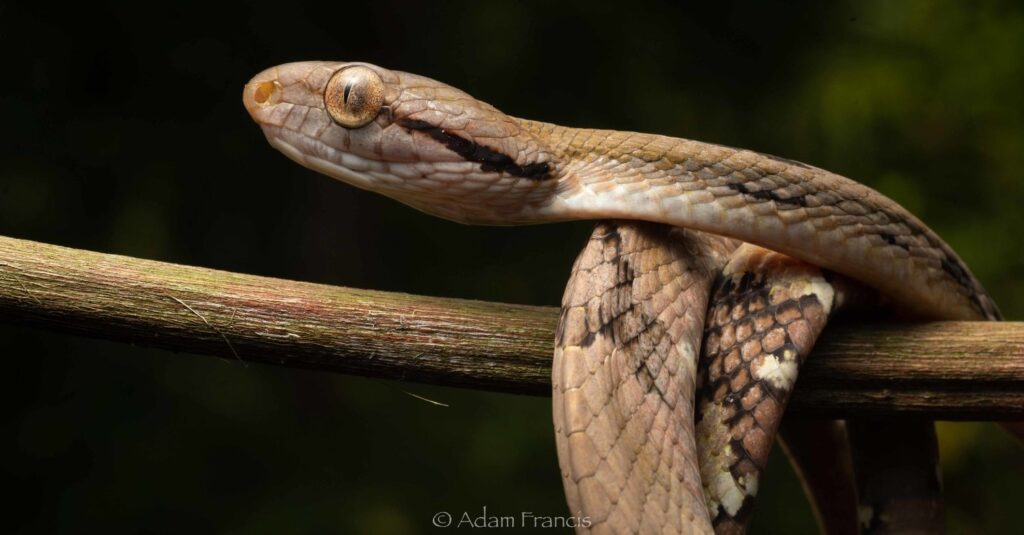
This snake splits its time between the ground and the trees. It’s brown with irregular black banding and white edges (this makes it distinct from kraits which have regular bands).
It mainly eats lizards and other snakes but will chow down on small mammals and birds too if it’s hungry enough.
Gold-Ringed Cat Snake

This is the biggest cat snake and it lives in mangrove forests in Bali. It has a black body and bright yellow bands. Its belly is also bright yellow.
Its venom isn’t terribly dangerous but this is an aggressive species and may bite multiple times if you encounter one. So, it is considered a dangerous species.
They make terrible pets too as their tempers don’t get better in captivity.
Marbled Cat Snake
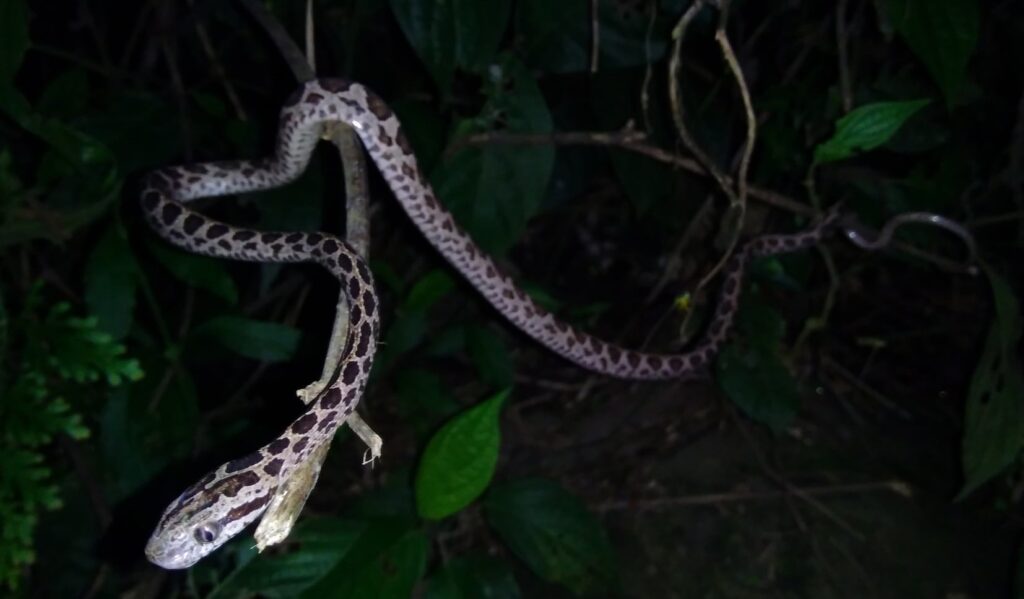
This is a much rarer cat snake and unusually it’s a “cathemeral” snake which means it’s active all day long.
This snake gives you a warning before it bites and will lash out with its mouth closed, but if you don’t get the hint, it will bite the second time around.
Slug Eater
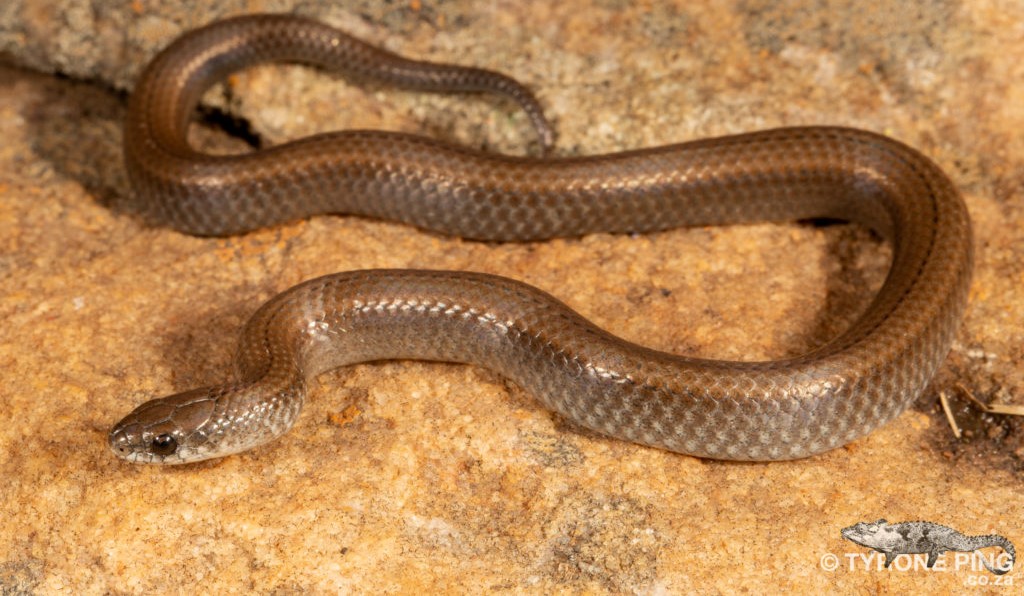
Yup, the name tells you what you need to know, this snake eats slugs. It’s not the prettiest snake in Bali but it may be the most docile.
You can handle these snakes with almost no chance of being bitten unless you are very rough and they have no venom even if they do bite.
Sunbeam Snake
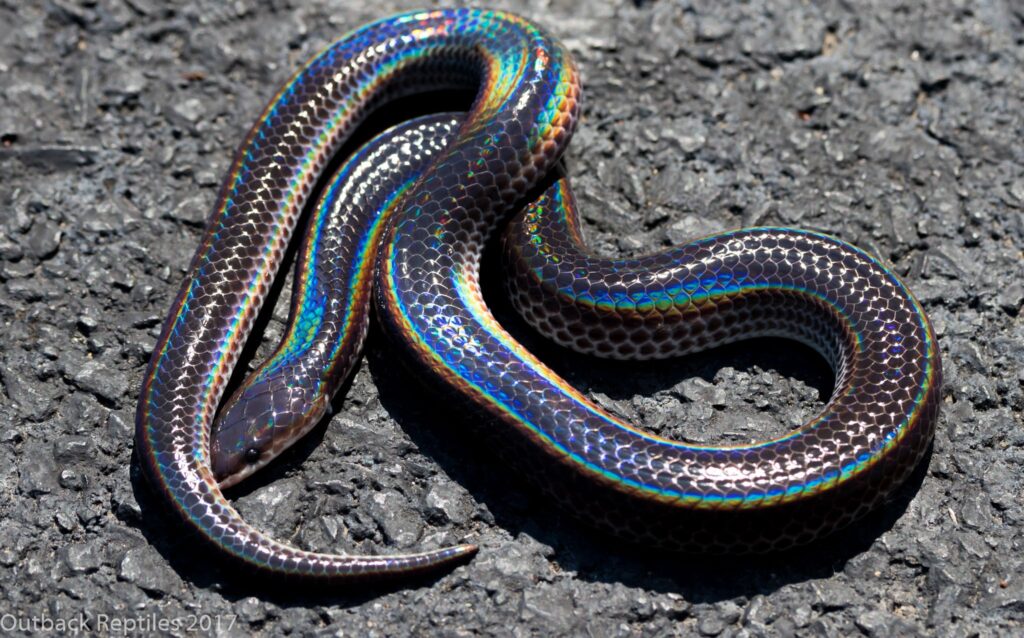
This is a gorgeous snake in sunlight, hence the name. It may also be one of the oldest species of snake in the world.
Black Copper Rat Snake
The black copper rat snake or Malayan racer is a terrestrial snake but one that can happily climb trees.
When threatened it can pretend to be a cobra by revealing a hood. But it has no venom. Don’t let that mislead you, though, its bite is very painful, indeed.
Boie’s Kukri Snake
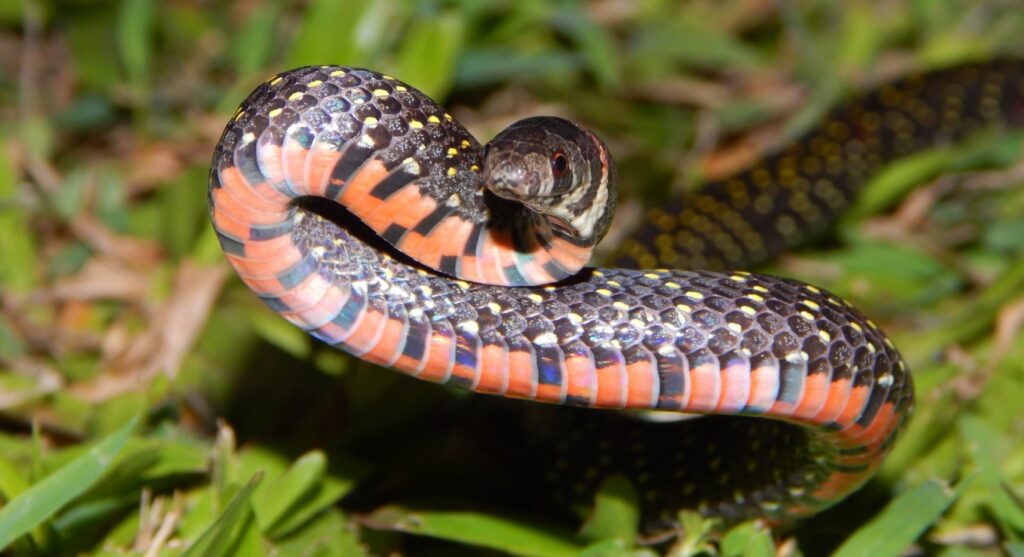
This specimen is named after the German herpetologist Heinrich Boie who is one of the greatest contributors towards our knowledge of Indonesian reptile life.
He discovered over 50 new species on the archipelago! This snake tends to make a meal of eggs but can eat very small animals if it needs to.
It’s not dangerous to people but interestingly, there is some suspicion that its venom is an anti-coagulant and that this might be worth investigating for medicinal uses.
Striped Keelback Water Snake
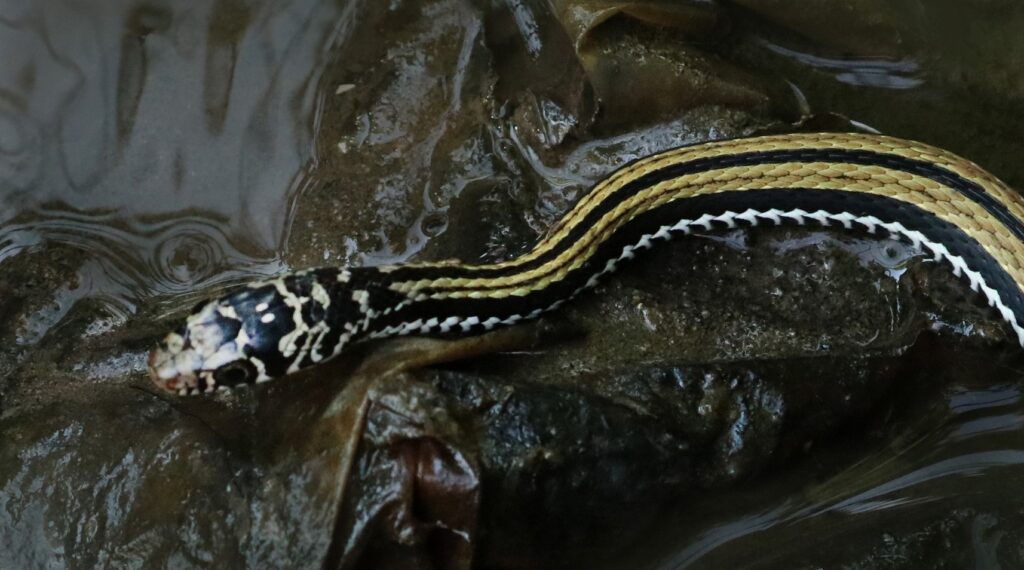
This is often called the “Indonesian Garter Snake” by collectors in the West but it’s not a garter snake.
It’s a brilliant snake to keep as a pet as it’s not at all hostile and not venomous either.
What To Do If You Are Bitten By Snakes In Bali?
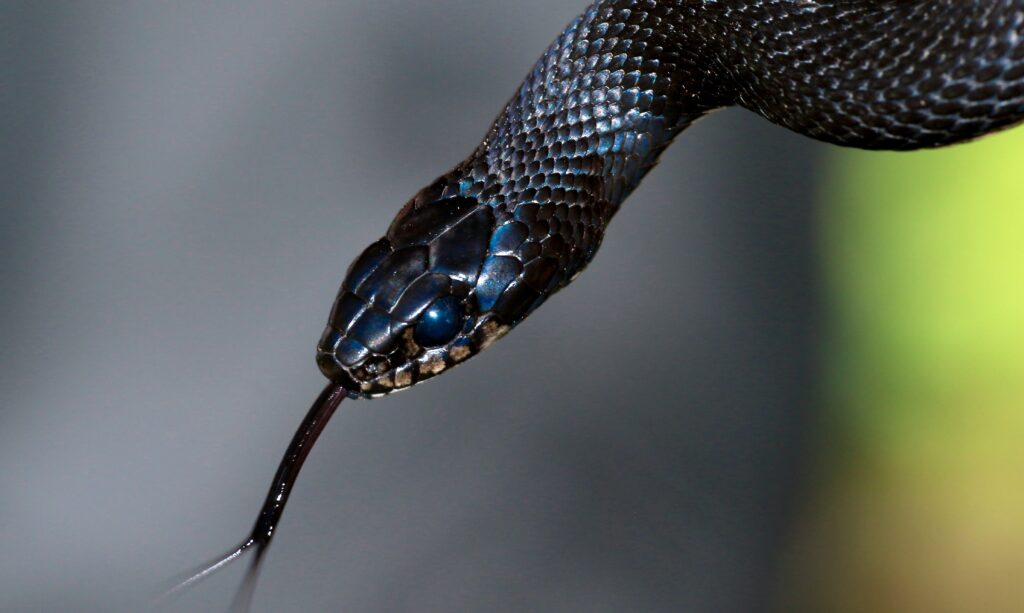
Given how hard it is to tell whether you have been bitten by one of the venomous snakes in Bali or something less dangerous, your main priority is to get to hospital after being bitten.
However, to start with you should follow these steps:
Ensure that the bitten individual is no longer near the snake – it’s easy to treat one bite rather than multiple snake bites
Ensure that the person rests and stays calm – panic will speed up their heart rate and make the venom move around the body faster
Carry out basic first aid based on the Danger, Response, Send for Help, Airway, Breathing, CPR and Defribiliate (DRSABCD) response as recommended by health authorities throughout the world.
Call for an ambulance or get the person in a car or taxi (which may be faster in Bali than waiting for an ambulance)
Use a pressure immobilization bandage to prevent the venom from spreading (if you can’t use this bandage due to the location of the wound, apply constant firm pressure to the area of the bite, instead)
In the event of an anaphylactic shock consider using an epi-pen if there’s one available
And whatever you do, please don’t:
Do not wash the area – identifying venomous snakes is easier if there’s a sample of the venom from any snake bites on the skin or clothes that can be analysed
Do not use a tourniquet – this can result in removing circulation from a limb and lead to its amputation
Do not cut into the wound – this will just hurt the victim and do nothing about the impact of any snake bites
Don’t suck out the venom – snake bites are full of poison, and you could end up poisoning yourself too
We should note that most snake bites are dry bites and you are unlikely to come to any real harm in most instances.
However, you should still get to the hospital as fast as possible just in case, things are more serious.
Sea snakes, in particular, have very strong venom and the speed of treatment is going to have a huge influence on the efficacy of any treatment.
Imported Snakes In Bali?
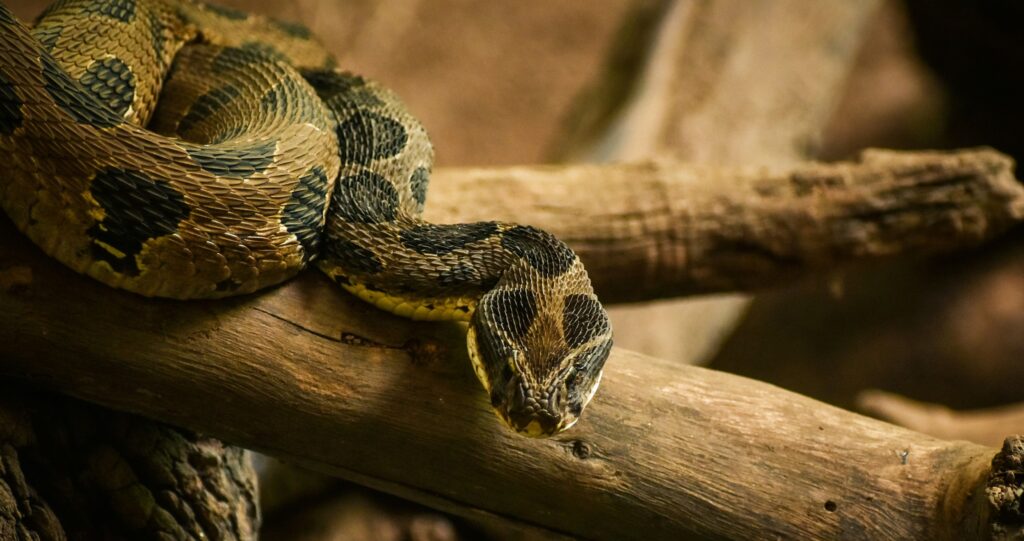
We should note that not all dangerous snakes in Bali are domestic species. In fact, many other snakes are imported by dealers from around the world as pets.
This can make snake identification very challenging for medical staff, sadly and there is definitely no rattlesnake anti-venom on the island.
Indonesian authorities do their best to prevent other snakes from being introduced into the Balinese ecology but it’s a very difficult thing to enforce.
Tips Regarding Snakes In Bali
We’ve got some basic tips regarding snakes in Bali for newcomers.
Do a little homework – you’re going to find it much easier to hand out a snake bite treatment or when a pit viper bites if you know what you’re doing. You don’t need a medical degree, but a little reading is a good idea.
Know that open-plan houses are most likely to see snakes – people have been sharing the island with snakes for a long time, now, so this isn’t a big deal but if you know they’re coming you can help reduce risks of a bite
Snake-proof where you can – carrying out some simple snake-proofing can reduce the chances of bites considerably. Don’t sleep on mats on the floor of an open-plan house, for example.
Know where your nearest hospital is – if you have a clinic on hand that you can get treated at, it’s best to have some idea where it is. Finding it when you’re stressed out and scared is going to be much harder.
Have a first aid kit handy – and make sure it has everything you need to deal with a bite in it.
Find a vet that can handle bites too – if you have pets, make sure your vet knows how to deal with a bitten cat or dog. Be warned, this kind of treatment is very expensive and may not be efficacious even if carried out quickly.
Tips For Being Around Snakes In Bali
If you want to minimize issues with snakes then try the following:
Once you see a snake, don’t run away. Instead, back away slowly. It almost certainly will not chase you.
Keep an eye on the snake. Make sure you know where it is.
Tell everyone nearby that there is a snake and where it is.
Never try to catch or kill a snake. That’s the number one way to get yourself bitten.
Take a photo of the snake using your camera. Most cameras have a zoom function, don’t get close to it. It’s easier to identify a snake from a photo than from a video.
Call a professional snake catcher. They will have all the tools necessary to catch and remove the snake. Under no circumstances should you pick up a snake or try and influence it with your hands.
FAQs
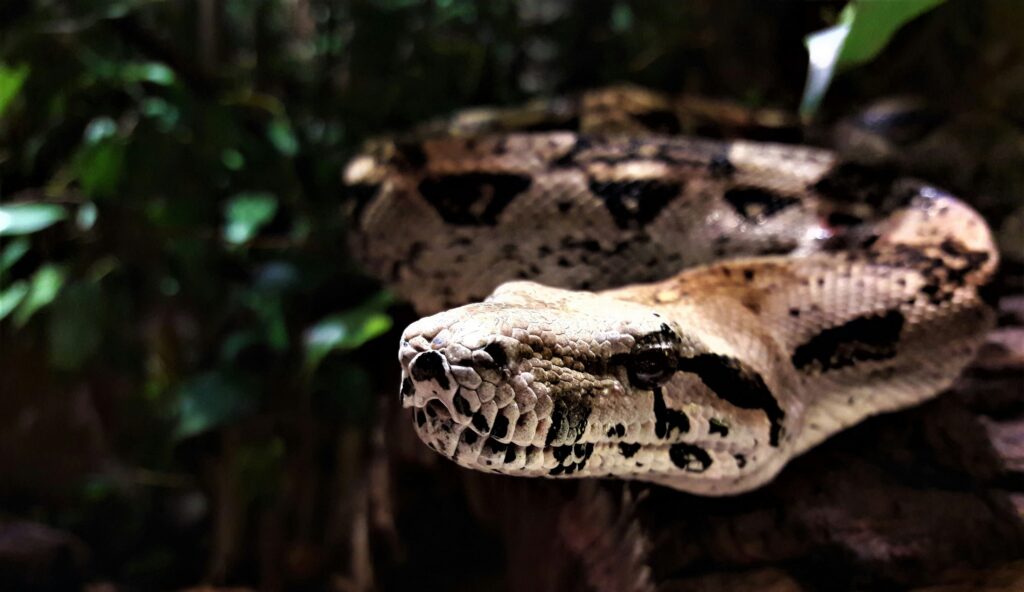
Are There Any Dangerous Snakes In Bali?
Yes! While the majority of the local snakes are non-venomous snakes, some of the snake species here are very venomous, indeed. The biggest venomous snake is the King Cobra and other venomous snakes include pit vipers and kraits.
That means that snake removals and snake rescues in Bali should only ever be carried out by professionals. Most of us are simply not properly equipped to remove a pit viper from our homes.
How Common Are Snakes In Bali?
Snakes are very common on the island but that doesn’t mean that every time you turn a street corner a dangerous species of snake will be lying in wait for you.
In fact, most people visit Bali and never see a snake at all. Mostly, they live in the rice fields or around rivers and only emerge infrequently in areas with human habitation.
They do come out more during the rainy season as water in their burrows can force them out onto land but if you spend your time in the centre of Canggu, you will probably never meet a snake at all, no matter how long you stay in Bali.
Are Sea Snakes Common In Bali?
Sort of. These snakes are most common in the waters around Australia and New Guinea and the vast majority of bites take place in these areas.
However, there are snakes in the seas of Bali. They can be very venomous too but the good news is that compared to land snakes, you really have to rile up a snake at sea to get it to bite you.
So, don’t grab them, poke them, etc. and you will almost certainly be able to enjoy a peaceful swim with no danger whatsoever to you or the snakes.
How Many Poisonous Snakes Are There In Bali? Is There Poisonous Snakes In Bali?
There are no poisonous snakes in Bali. In fact, there are no poisonous snakes anywhere in the world!
If that makes you think we’re lying, we understand why, but it’s true. Some snakes are venomous. That means that if they bite you, they can inject venom into you that can be harmful or kill you.
Bali has plenty of venomous snakes.
But poisonous is a term we use to describe what happens if you bite into something (or breathe it in).
You can safely cook and eat snakes because they aren’t poisonous. In fact, their venom tends to break down with heat too – so, you won’t get sick from eating heated snake venom either.
That’s why snakes aren’t poisonous but are venomous. It’s an annoying quirk of the English language but an important distinction when it comes to the scientific understanding of various toxins.
Are Snakes A Problem In Bali?
Define “problem”? Snakes are an important part of the Balinese ecosystem, they keep rodents, lizards and other kinds of pests under control.
Without snakes the rice fields would be overrun with pests and the harvests would fail.
So, they’re not a problem in that respect.
However, there’s no doubt that human encroachment into snake territory has brought snakes and people together in ways that are not always mutually beneficial.
Snake bites are on the rise and that’s not the fault of the snakes but the fault of people who keep coming into snake territory and then not knowing how to behave around snakes.
Does Ubud Have Snakes?
Yes, in fact, because there are plenty of rice fields in Ubud, there are plenty of snakes there too.
Though the overall concentration of snakes may be slightly lower in Ubud due to its altitude, you are more likely to encounter a snake in the rainforest (particularly in the rainy season) or in the fields than you are in a hotel in Kuta or Seminyak.
Having said that, snakes really don’t like people and aren’t looking to get into a fight. Thousands of people will visit Ubud every single day and never see a snake there.
Are Cobras Native To Bali?
They are now. The spitting cobra is probably a long-term resident of Bali but the King Cobra is a relatively new arrival from other parts of Indonesia.
Cobras can be found on most of the major islands in the archipelago and quite possibly on some of the smaller islands too. There are a lot of islands in Indonesia and nobody has surveyed them all for snakes.
Do I Need To Worry About Snakes In Bali?
No, though the snakes might appreciate learning that you care. Just kidding.
We know what you mean, really, but the answer is still a resounding “no”. The vast majority of tourists will never see a snake in Bali, those who do will almost certainly not have any trouble with a snake in Bali.
There is certainly no suggestion in the local press that snake bites on tourists are a regular occurrence (in fact, we couldn’t find a single reported incident in recent history).
If you do encounter a snake, follow our guidance above and you’ll be just fine. Remember they don’t want to bite you.
Final Thoughts On Snakes In Bali
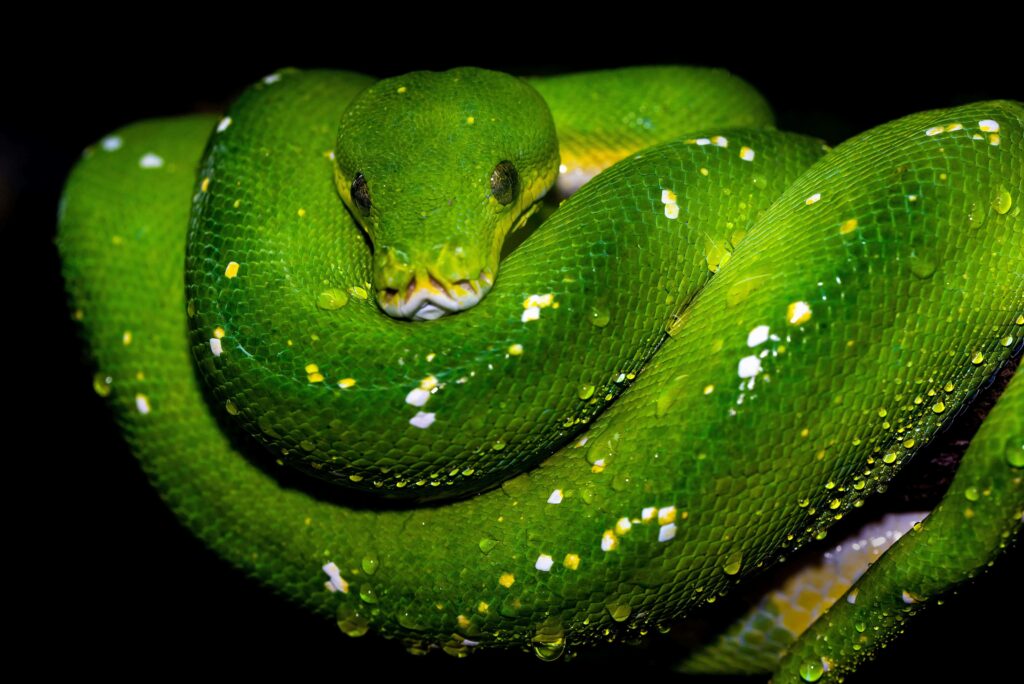
There are plenty of snake species in Bali and yet, you will probably never see a snake here unless you go looking for it.
Most snake bites do not result in death and overall, Bali’s beautiful snake species are more of a curiosity for most tourists rather than a threat.
Certainly, you shouldn’t all the thought of venomous snakes in Bali deter you from booking your holiday in this lovely part of Southeast Asia.
Snakes and tourists, for now, coexist quite happily here on Paradise Island.

